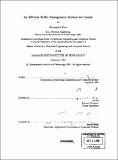An efficient buffer management methods for Cachet
Author(s)
Kim, Byungsub, 1978-
DownloadFull printable version (3.607Mb)
Other Contributors
Massachusetts Institute of Technology. Dept. of Electrical Engineering and Computer Science.
Advisor
Arvind.
Terms of use
Metadata
Show full item recordAbstract
(cont.) running simulation. Third, since BCachet is almost linear under the assumption of a reasonable number of sites, BCachet is very scalable. Therefore, it can be used to for very large scale multiprocessor systems. We propose an efficient buffer management method for Cachet [7], called BCachet. Cachet is an adaptive cache coherence protocol based on a mechanism-oriented memory model called Commit-Reconcile & Fences (CRF) [1]. Although Cachet is theoretically proved to be sound and live, a direct implementation of Cachet is not feasible because it requires too expensive hardware. We greatly reduced the hardware cost for buffer management in BCachet without changing the memory model and the adaptive nature of Cachet. Hardware cost for the incoming message buffer of the memory site is greatly reduced from PxN FIFOs to two FIFOs in BCachet where P is the number of sites and N is the number of address lines in a memory unit. We also reduced the minimum size of suspended message buffer per memory site from (log₂ P+V) xPx(rq[max]), to log₂ P where V is the size of a memory block in terms of bits and rqma is the maximum number of request messages per cache. BCachet has three architectural merits. First, BCachet separates buffer management units for deadlock avoidance and those units for livelock avoidance so that a designer has an option in the liveness level and the corresponding hardware cost: (1) allows a livelock with an extremely low probability and saves hardware cost for fairness control. (2) does not allow a livelock at all and accept hardware cost for fairness control. Second, a designer can easily parameterize the sizes of buffer units to explore the cost-performance curves without affecting the soundness and the liveness. Because usual sizes of buffer management units are much larger than the minimum sizes of those units that guarantee the liveness and soundness of the system, a designer can easily find optimum trade-off point for those units by changing size parameters and
Description
Thesis (S.M.)--Massachusetts Institute of Technology, Dept. of Electrical Engineering and Computer Science, 2004. Includes bibliographical references (leaves 83-85).
Date issued
2004Department
Massachusetts Institute of Technology. Department of Electrical Engineering and Computer SciencePublisher
Massachusetts Institute of Technology
Keywords
Electrical Engineering and Computer Science.